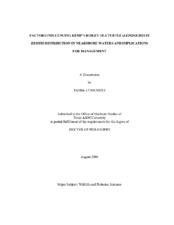| dc.contributor.advisor | Landry, Andre M., Jr. | |
| dc.creator | Metz, Tasha Lynn | |
| dc.date.accessioned | 2004-11-15T19:51:48Z | |
| dc.date.available | 2004-11-15T19:51:48Z | |
| dc.date.created | 2004-08 | |
| dc.date.issued | 2004-11-15 | |
| dc.identifier.uri | https://hdl.handle.net/1969.1/1247 | |
| dc.description.abstract | Post-pelagic juvenile and subadult Kemp's ridley sea turtles (Lepidochelys kempii) (20-40 cm straight carapace length) utilize nearshore waters of the northwestern Gulf of Mexico as nursery or developmental feeding grounds. This study utilizes 10 years of entanglement netting data to characterize long-term abundance and distribution of Kemp's ridley sea turtles at index habitats in this region. Netting surveys were conducted during April-October 1993-2002, primarily at Sabine Pass, Texas and Calcasieu Pass, Louisiana. Additionally, this study takes an ecosystem-based approach to understanding factors influencing Kemp's ridley in-water abundance and distribution via the development of a conceptual model incorporating data on nesting dynamics, environmental conditions, prey availability, and predation pressure.
Overall monthly mean ridley catch-per-unit-effort (CPUE) peaked in the beginning of summer (April-June), probably in response to rising water temperatures and seasonal occurrence of blue crab prey. Annual mean ridley CPUE across all study areas peaked in 1994, 1997, 1999 and 2002, suggesting a 2-3 year cycle in abundance that may be related to patterns in clutch size or hatch success at the Rancho Nuevo, Mexico nesting beach. However, ridley CPUE in nearshore waters remained relatively constant or decreased slightly even as number of hatchlings released from Rancho Nuevo increased exponentially. Annual declines in Texas strandings since 1994 and subsequent increases in Florida counterparts since 1995 suggest a shift in ridley distribution from the western to eastern Gulf in recent years.
Significant declines in ridley CPUE at Sabine Pass since 1997 coincided with a concurrent reduction in blue crab size, but a similar trend was not detected at Calcasieu Pass. Kemp's ridley occurrence at study sites was not significantly related to shrimping activity/by-catch. There also were no biologically significant relationships between Kemp's ridley CPUE and abiotic factors, nor were ridleys deterred from utilizing areas frequented by bull sharks. Overall, nesting dynamics and prey availability were conceptual model components appearing to have the greatest influence on nearshore ridley occurrence. | en |
| dc.format.extent | 6951913 bytes | en |
| dc.format.extent | 250659 bytes | en |
| dc.format.medium | electronic | en |
| dc.format.mimetype | application/pdf | |
| dc.format.mimetype | text/plain | |
| dc.language.iso | en_US | |
| dc.publisher | Texas A&M University | |
| dc.subject | Kemp's ridley sea turtle | en |
| dc.subject | long-term in-water dynamics | en |
| dc.subject | nearshore abundance and distribution | en |
| dc.subject | ecosystem-based approach | en |
| dc.subject | conceptual model | en |
| dc.subject | nesting activity | en |
| dc.subject | environmental conditions | en |
| dc.subject | prey availability | en |
| dc.subject | blue crab size and abundnace | en |
| dc.subject | predation pressure | en |
| dc.subject | bull shark abundance | en |
| dc.title | Factors influencing Kemp's ridley sea turtle (Lepidochelys kempii) distribution in nearshore waters and implications for management | en |
| dc.type | Book | en |
| dc.type | Thesis | en |
| thesis.degree.department | Wildlife and Fisheries Sciences | en |
| thesis.degree.discipline | Wildlife and Fisheries Sciences | en |
| thesis.degree.grantor | Texas A&M University | en |
| thesis.degree.name | Doctor of Philosophy | en |
| thesis.degree.level | Doctoral | en |
| dc.contributor.committeeMember | Webb, James W. | |
| dc.contributor.committeeMember | Packard, Jane M. | |
| dc.contributor.committeeMember | Fitzgerald, Lee A. | |
| dc.type.genre | Electronic Dissertation | en |
| dc.type.material | text | en |
| dc.format.digitalOrigin | born digital | en |


